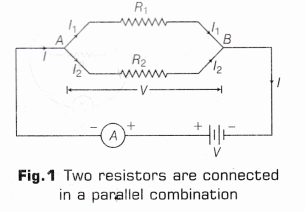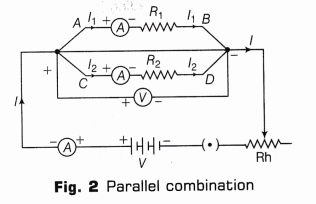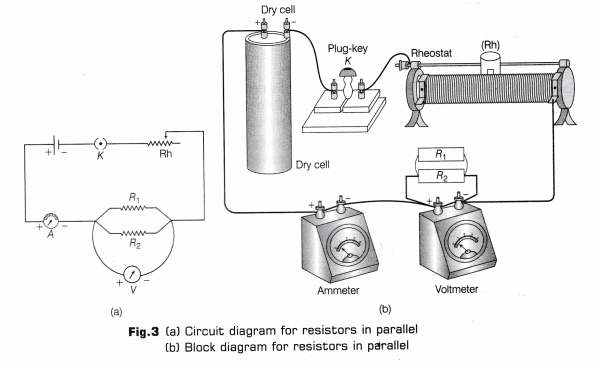CBSE Class 10 Science Lab Manual – Resistors in Parallel
Aim
To determine the equivalent resistance of two resistors, when connected in parallel combination.
Materials Required
Two standard resistance coils (or resistors), ammeter (0-1.5 A), voltmeter (0-1.5 V), one-way plug key, a low resistance rheostat, connecting wires, a piece of sand paper and cell or battery eliminator.
Theory/ Principle
An arrangement of resistors in which number of resistors are connected between two common points in such a way that the potential difference across each resistor is equal to the applied voltage is called parallel combination of resistances.

As shown in Fig. 1, two resistors of resistances R1 and R2 are connected between two points A and B in parallel combination. Let the potential difference applied by the DC source to this combination be V.
Let I1 and I2 be the currents measured by an ammeter, connected in series with each resistor R1 and R2 respectively, then
I = I1+I2 …….(i)
According to Ohm’s law,
I1 = \(\frac { V }{ { R }_{ 1 } }\) and I2 = \(\frac { V }{ { R }_{ 2 } }\) ……..(ii)
If Rp is the equivalent resistance of the given parallel combination, having the same potential difference as the applied potential, then
I= \(\frac { V }{ { R }_{ p } }\) ………(iii)
From Eqs. (i), (ii) and (iii), we get
\(\frac { V }{ { R }_{ p } }\) = \(\frac { V }{ { R }_{ 1 } }\) + \(\frac { V }{ { R }_{ 2 } }\)
or
\(\frac { 1 }{ { R }_{ p } }\) = \(\frac { 1 }{ { R }_{ 1 } }\) + \(\frac { 1 }{ { R }_{ 2 } }\)
or
or
\(\frac { { R }_{ 1 }{ R }_{ 2 } }{ { R }_{ 1 }+{ R }_{ 2 } }\)
Therefore, when number of resistances are connected in a parallel combination, the reciprocal of the equivalent resistance is equal to the sum of the reciprocals of the individual resistances.
Procedure
- Note down the least count and zero error (if any) of the given ammeter and voltmeter.
- Clean the ends of connecting wires using sand paper.
- Find the values of two given resistances R1 and R2 by the procedure given in Experiment5

- Connect the given resistors in parallel combination between the two terminals of the voltmeter (as shown in Fig. 3).

- Put the plug in the key and take the readings of ammeter and voltmeter (as done in Experiment 5).
- Repeat the step 5 three times by changing the position of the sliding contact of the rheostat (as done in Experiment 5).
- Tabulate the readings and find the ratio of V and I. It will give the equivalent resistance of the combination.
Observation
- Least count of ammeter = ………… A
- Zero error of ammeter = ………….. A
- Least count of voltmeter = ………. V
- Zero error of voltmeter = …………. V
- Zero correction in ammeter reading = ……….. A
- Zero correction in voltmeter reading = ………… V
| Resistor used | Observations | Voltmeter reading (volt) | Ammeter reading (arnpere) | R = V/I (ohm) | Mean value Of resistance (Ohnn) |
| R1 | (a) | ||||
| R2 | (a) | ||||
| Rp= \(\frac { { R }_{ 1 }{ R }_{ 2 } }{ { R }_{ 1 }+{ R }_{ 2 } }\) | (a) |
Calculations
- Mean value of R1 = ……….. Ω
- Mean value of R2 = ………. Ω
Equivalent value of parallel combination,- By calculations, R’p = \(\frac { { R }_{ 1 }{ R }_{ 2 } }{ { R }_{ 1 }+{ R }_{ 2 } }\) = ……….. Ω
- By experiment, Rp = …………. Ω
Result
- The equivalent resistance of parallel combination, Rp = ………….. Ω
- There is close agreement between the calculated value and the value obtained by the experiment. Hence,
\(\frac { 1 }{ { R }_{ p } }\) = \(\frac { 1 }{ { R }_{ 1 } }\) + \(\frac { 1 }{ { R }_{ 2 } }\) is verified.
Percentage Error
Percentage Error = \(\frac { Experimental\quad Value-Calculated\quad Value }{ Calculated\quad Value } \times 100\) = ………. %
It shows that percentage error is within the experimental error.
Precautions
- It is to be properly checked that ammeter is connected in series and voltmeter is connected in parallel.
- The connecting wires should be thick and must have tight connection at joints.
- The ends of connecting wires should be cleaned properly using sand paper.
- The ammeter and voltmeter must be of proper range and of less least count.
- Current should be passed for very short time, otherwise heating effect can change the actual result.
Sources of Error
- Reading error may be possible while observing the pointer of ammeter and voltmeter.
- Thick connecting wires may not be available at the time of performing the experiment.
- Area of cross-section of resistance may not be uniform across the length of wire.
- The high resistance rheostat may be used.
- Current may be allowed for longer period.
- The terminal screws of the instruments may not be tightened properly.
Viva – Voce
Question 1.
If two resistors having resistances of 3Ω and 6Ω respectively are connected in parallel, what will be the net resistance in the circuit? [NCERT]
Answer:
The net resistance or equivalent resistance of the circuit is given by
Req = \(\frac { { R }_{ 1 }{ R }_{ 2 } }{ { R }_{ 1 }+{ R }_{ 2 } }\) = \(\frac { 3\times 6 }{ 9 }\) = 2Ω
Question 2.
Two resistors having resistances of 4Ω and 6Ω respectively are connected in a circuit. It was found that the total resistance in the circuit is less than 4Ω. In what way the resistances would have been connected? [NCERT]
Answer:
As we know that, for parallel combination, net resistance is less than that of individual resistance. So, they are connected in parallelwith each other.
Question 3.
Two resistors are connected in series and then in parallel. What effect will it have on the readings of voltmeter and ammeter? [NCERT]
Answer:
As the applied voltage remains same, so there will be no change in the reading of voltmeter. Ammeter reading will be less in case of series and more in case of parallel.
Question 4.
In what way, household appliances should be connected? [NCERT]
Answer:
Household appliances must be connected in parallel.
Question 5.
State the law for the equivalent resistance, when resistors are in parallel combination.
Answer:
Law states that the reciprocal of equivalent resistance is equal to the sum of the reciprocal of individual resistances.
Question 6.
Name the type of connection used in house wiring.
Answer:
In our house wiring, parallel connection of appliances is used.
Question 7.
What is the ratio in which current divides itself in the parallel combination?
Answer:
The current divides itself in the inverse ratio of resistance in parallel combination (i.e. I ∝ \(\frac { 1 }{ R }\)).
Question 8.
Can you explain why voltmeter is connected in parallel across the conductor?
Answer:
It is connected in parallel across the conductor to measure the maximum potential drop.
Question 9.
Define range of an ammeter.
Answer:
Range of an ammeter is defined as the maximum and minimum values of current that can be measured through an ammeter without any damage.
Question 10.
Name the quantity which remains same in parallel combination of resistors.
Answer:
In parallel combination of resistors, voltage (V) remains same.
Question 11.
State some disadvantages of parallel circuit.
Answer:
- As one fuse controls all light, fans, and other electric appliances of a single room, circuit all of them will be put off when the fuse blow off.
- It is difficult to install a new circuit for new installation of electrical appliances.
Question 12.
If two resistors of resistances R1 and R2 respectively are connected in parallel. How will you find the equivalent resistance?
Answer:
If two resistors of resistances R1 and R2 respectively are connected in parallel, then equivalent resistance can be given as
\(\frac { 1 }{ { R }_{ p } }\) = \(\frac { 1 }{ { R }_{ 1 } }\) + \(\frac { 1 }{ { R }_{ 2 } }\)
Question 13.
Suppose in a combination, we find that the equivalent resistance is smaller than the smallest resistance used in the circuit. Which type of combination is present in the circuit?
Answer:
It is a parallel combination.
Question 14.
What is the effect of temperature on the value of resistance of a conductor?
Answer:
The resistance of conductor increases with increase in temperature.
Question 15.
What do you mean by the range of voltmeter?
Answer:
The maximum and.minimum values of potential difference that can be measured through a voltmeter without any damage defines the range of voltmeter.
Science Lab ManualScience Practical SkillsScience LabsMath LabsMath Labs with Activity